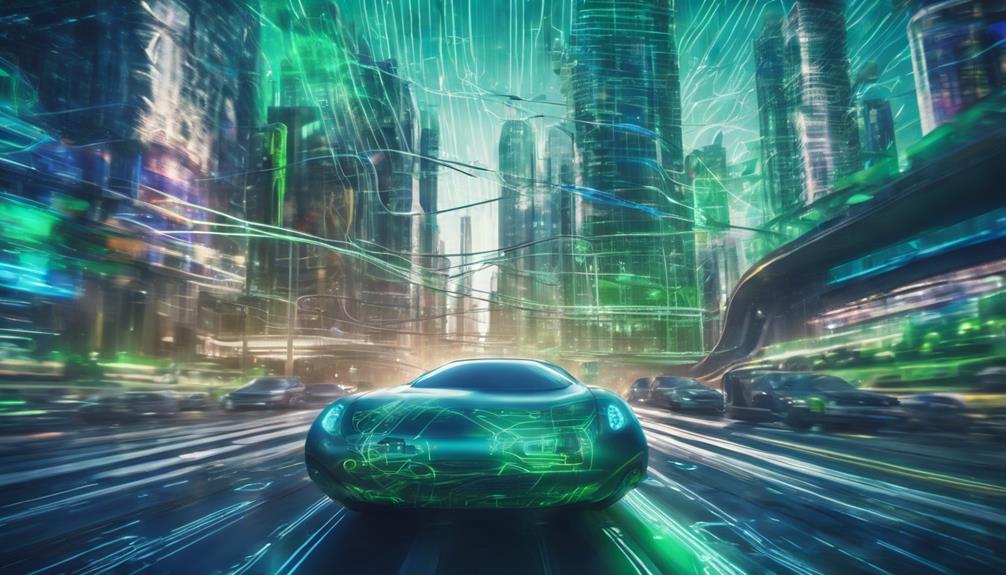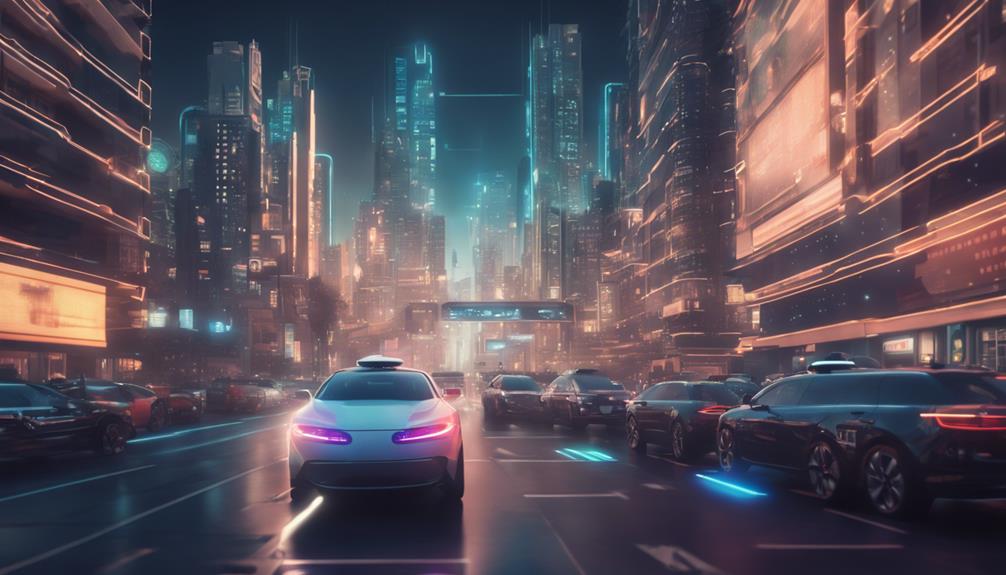
7 Best Strategies for AI in Autonomous Vehicles
June 15, 2024You're about to reveal the 7 game-changing strategies that are propelling the development of autonomous vehicles. From predicting real-time events with advanced AI algorithms to leveraging sensor fusion for surroundings perception, these innovations are transforming the transportation landscape. You'll discover how natural language processing integration, object recognition systems, and real-time data analysis are creating a safer, more efficient, and personalized experience. By mastering these breakthroughs, you'll be on the fast track to unleashing the full potential of autonomous vehicles. And as you explore these cutting-edge strategies, you'll uncover the secrets to revolutionizing the way we travel.
Advanced Predictive Modeling Techniques
By leveraging advanced predictive modeling techniques, autonomous vehicles can tap into the power of complex algorithms to anticipate and respond to real-time events on the road.
You'll be amazed at how these techniques harness the potential of machine learning and deep learning algorithms to improve the accuracy of predictions in autonomous driving scenarios.
As you navigate through dynamic situations, predictive modeling helps you make informed decisions based on real-time data and historical patterns. This enables you to proactively adjust your behavior to navigate challenging road conditions and avoid potential hazards.
With advanced predictive modeling, you can predict and respond to unexpected events, ensuring a safer and more efficient ride.
Robust Sensing and Perception Capabilities
As you navigate through complex environments, your autonomous vehicle relies on a sophisticated suite of sensors to perceive and understand its surroundings, ensuring safe and efficient travel. This robust sensing and perception capabilities are made possible by the combination of lidar, radar, cameras, and ultrasonic sensors.
Lidar systems generate over 1 million data points per second, enabling precise mapping and object detection. Radar sensors can detect objects at long distances and through various weather conditions, enhancing safety. Cameras capture high-resolution images for visual recognition of traffic signs, lane markings, and objects. Ultrasonic sensors provide close-range detection to aid in parking and maneuvering in tight spaces.
The AI system processes and integrates data from these sensors to create a detailed picture of the environment, allowing your autonomous vehicle to make informed decisions. By leveraging these advanced sensors and AI algorithms, your vehicle can navigate complex scenarios with confidence and precision, ensuring a safe and enjoyable ride.
Efficient Decision-Making Algorithms

With robust sensing and perception capabilities in place, your autonomous vehicle can now focus on making swift and informed decisions, thanks to efficient decision-making algorithms that process real-time data to navigate complex driving scenarios.
These algorithms are the backbone of your vehicle's ability to react to unexpected events, avoid obstacles, and adhere to traffic rules. By leveraging advanced machine learning techniques, decision-making algorithms can analyze vast amounts of sensor data in real-time, predicting the best course of action to guarantee safe navigation.
The effectiveness of these algorithms directly impacts the overall performance and safety of your autonomous vehicle on the road. With the ability to process vast amounts of data quickly, your vehicle can make informed decisions in a split second, ensuring obstacle avoidance and adherence to traffic rules.
Seamless Natural Language Processing
You can effortlessly converse with your autonomous vehicle, thanks to seamless natural language processing (NLP) integration, which enables you to issue voice commands and receive responses in a conversational tone.
This advanced AI-powered NLP technology translates spoken language into actionable commands, allowing you to control navigation and entertainment systems with ease. With hands-free communication, you can focus on the road while still enjoying a personalized experience.
The integration of AI and NLP enhances user experience, providing intuitive and conversational interactions that make you feel like you're interacting with a personal assistant. Advanced NLP systems can understand and respond to natural language queries, making it easy to get information or adjust settings without taking your eyes off the road.
As you navigate through your journey, seamless NLP integration guarantees a safe and convenient ride, allowing you to relax and enjoy the benefits of autonomous vehicles.
Sophisticated Object Recognition Systems

As you delve into the domain of sophisticated object recognition systems in autonomous vehicles, you'll discover the importance of accurate scene understanding. This involves the AI system's ability to correctly identify and classify objects within a scene, taking into account various factors like lighting, weather, and object orientation.
Accurate Scene Understanding
As you explore the world of autonomous vehicles, you'll realize that sophisticated object recognition systems, powered by AI algorithms like deep learning, enable autonomous vehicles to accurately understand their surroundings by processing vast amounts of sensor data from cameras, LiDAR, and radar.
This important scene understanding is vital for safe navigation, allowing the vehicle to detect and classify diverse objects such as pedestrians, vehicles, and traffic signs in real-time. AI algorithms continuously learn and improve object recognition capabilities through training on vast datasets, enhancing the overall perception and decision-making process of autonomous vehicles.
By processing sensor data from multiple sources, AI-powered object recognition systems can accurately detect objects, even in complex scenarios. This precise detection enables the vehicle to make informed decisions, ensuring a safe and efficient journey.
As you explore the role of AI in autonomous vehicles, it's evident that accurate scene understanding is an essential component, and AI algorithms are the driving force behind this capability.
Real-time Object Detection
Processing vast amounts of sensor data in real-time, sophisticated object recognition systems in autonomous vehicles can detect and classify objects on the road instantly, enabling the vehicle to respond to dynamic road conditions and guarantee smooth and safe driving.
You're probably wondering how this works. It's all thanks to AI algorithms that process sensor data in real-time to detect and track objects like vehicles, pedestrians, cyclists, and obstacles. Advanced computer vision techniques are used to analyze the environment and make split-second decisions for safe navigation.
Real-time object detection is essential for autonomous vehicles to react to dynamic road conditions and uphold smooth and safe driving. By using sophisticated object recognition systems, you can prevent accidents, improve traffic flow, and enhance overall road safety.
With real-time object detection, you can trust that your autonomous vehicle will navigate roads safely and efficiently.
Real-Time Behavior Prediction Analysis
As you delve into the world of Real-Time Behavior Prediction Analysis in autonomous vehicles, you'll discover that predictive analytics plays a crucial role in anticipating the actions of other road users.
To achieve this, advanced sensor fusion and real-time data processing are indispensable, enabling your AI system to make proactive decisions and guarantee safe navigation.
Predictive Analytics Role
By analyzing real-time data, you can predict the behavior of other vehicles, pedestrians, and road conditions, enabling your autonomous vehicle to anticipate and react to potential hazards on the road. This is made possible through predictive analytics, which utilizes machine learning algorithms to analyze real-time data and predict the actions of surrounding elements. By continuously analyzing and predicting the actions of other vehicles, pedestrians, and road conditions, your autonomous vehicle can navigate complex traffic scenarios with precision.
Predictive analytics plays an essential role in enhancing the safety and efficiency of self-driving cars by enabling proactive decision-making. By anticipating potential hazards, your autonomous vehicle can take proactive measures to avoid accidents and ensure a smooth driving experience. This is particularly important in dynamic and unpredictable road situations, where the ability to adapt quickly is critical.
Advanced Sensor Fusion
Combining data from multiple sensors like LiDAR, radar, and cameras, advanced sensor fusion technology plays a vital role in enabling your autonomous vehicle to pinpoint its surroundings in real-time, predicting the behavior of other road users and obstacles with unprecedented accuracy. This technology is essential for your vehicle's perception of its environment, allowing it to make informed decisions in complex driving scenarios.
By integrating real-time data from various sensors, you can anticipate the actions of other vehicles, pedestrians, and obstacles on the road. This predictive capability is made possible by AI algorithms that analyze the fused sensor data, enabling your vehicle to proactively adjust its driving behavior. With advanced sensor fusion, you can enhance safe navigation by detecting potential hazards and responding accordingly.
Real-Time Data Processing
In the blink of an eye, your autonomous vehicle must process a staggering amount of sensor data to predict the behavior of other road users and obstacles, making real-time data processing a vital component of safe and efficient navigation.
You see, essential behavior prediction analysis is vital in autonomous vehicles, as it enables the AI algorithms to analyze vast amounts of sensor data in milliseconds. This analysis allows your vehicle to make split-second decisions, ensuring you navigate through dynamic traffic scenarios safely and efficiently.
Advanced AI systems in autonomous vehicles can process terabytes of data per hour, anticipating and responding to changing road conditions in real-time.
This real-time data processing is essential for ensuring passenger safety, as it enables your vehicle to adapt to unexpected events and make informed decisions quickly.
Continuous Evolution and Adaptation

Through continuous over-the-air updates, your autonomous vehicle is constantly refining its performance, ensuring you're always driving with the latest advancements in AI technology.
This continuous evolution is essential, as it allows your vehicle to adapt to new information and scenarios, ensuring peak performance in an ever-changing environment.
Feedback loops play a critical role in this process, enabling continuous learning and enhancement in autonomous vehicle technology.
Real-world performance data is collected and analyzed to refine algorithms and optimize autonomous driving systems.
This ongoing improvement process allows your vehicle to enhance its capabilities through artificial intelligence, ensuring you're always driving with the latest advancements.
As you drive, your vehicle continuously adapts to changing conditions, refining its performance and enhancing its capabilities.
This continuous adaptation is made possible by the power of artificial intelligence, which enables your vehicle to learn and improve over time.
Conclusion
As you navigate the road to autonomous vehicles, remember 'Rome wasn't built in a day.'
These 7 AI strategies –
advanced predictive modeling,
robust sensing,
efficient decision-making,
seamless NLP,
sophisticated object recognition,
real-time behavior prediction,
and continuous evolution –
are the building blocks of a self-driving future.
By mastering these, you'll be one step closer to creating vehicles that can outsmart, outmaneuver, and outperform human drivers.
The road ahead is long, but with these strategies, you'll be driving towards a safer, more efficient tomorrow.


